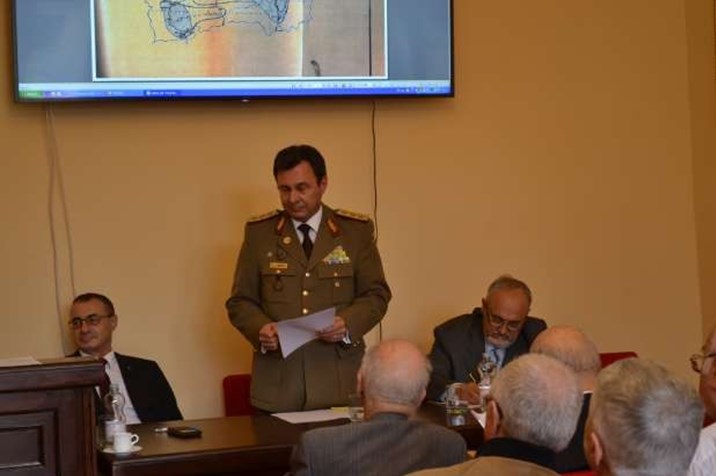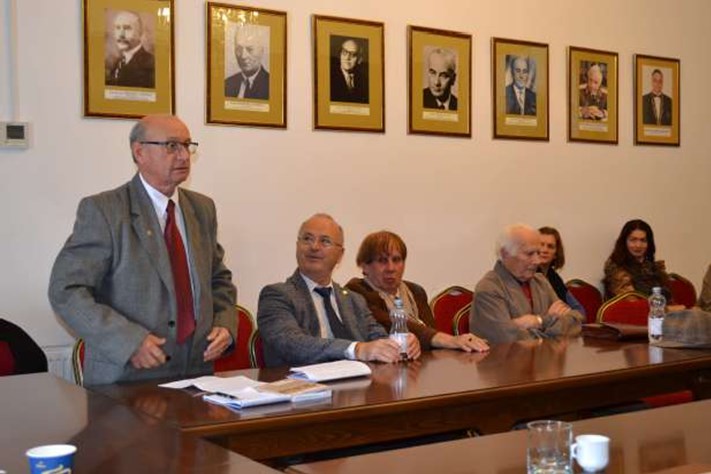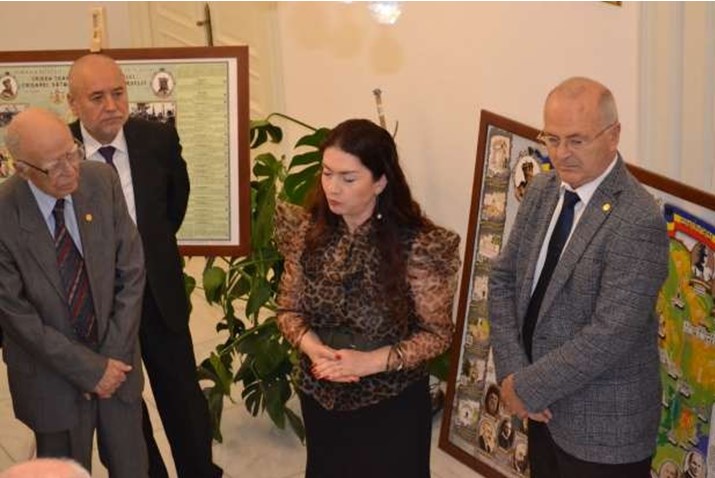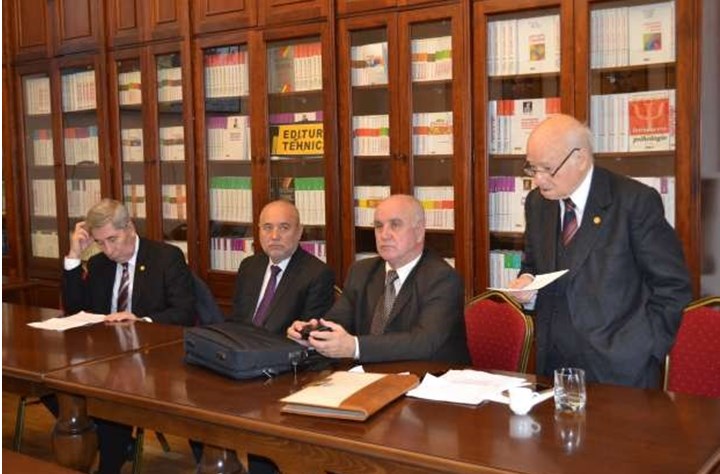In the series of events dedicated to the Centenary of the Great Union, started in 2018, the Academy of Romanian Scientists has launched in the academic agora and in the national public space, for reflection and analysis, a new theme of major interest for Romanian history and consciousness, related to the period immediately following the fulfillment of the national ideal of the Union. Under the title INTERNAL AND EXTERNAL FRAMEWORK OF THE DEFENCE OF THE ENTIRE ROMANIA IN 1919, AOSR organized an academic debate focused on the political and military processes and developments after the historic act of 1 December 1918. The event took place on 13 November, starting at 11.00 a.m., in the Conference Room of the AOSR “Dr. Constantin I. Angelescu” (headquarters of the institution, 3 Ilfov Street, sector 5, Bucharest).

The debate was attended by members of academia, representatives of state institutions, scientists and scholars, PhD students, students. The event was organized with the support of the Section of Historical and Archaeological Sciences (President: Prof. Ion Solcanu) and the Section of Military Sciences (President: Gen. (r) Prof. Teodor Frunzeti).
In the opening, Prof. Dr. Eng. Adrian Badea, President of the Academy of Romanian Scientists, the host of the Debate, said that the event is part of the series of events and scientific events organized by AOSR in the framework of the Centenary of the Great Union, which aim, on the one hand, to provide new scientific contributions to the analysis and knowledge of the historical framework, of the events of the period and their meanings, on the other hand, to promote the great moments of a century ago, the struggle of the Romanian nation for the achievement of the Great Union and the accomplishment of Greater Romania as a history lesson, with exemplary value for today’s generations, especially for young people. In this context, President Adrian Badea said that the Academy of Scientists pays programmatic attention to young people in high school and university, through programs and projects dedicated to their development in terms of scientific, cultural, moral and identity values.

On behalf of the Presidential Administration, was present Gen. Mihai Șomordolea, State Counsellor, Department of National Security, Secretary of the Supreme Council of National Defence, who presented the evolution of the concept and security organizations since the end of the First World War until today, from the point of view of ensuring Romania’s security, concluding that today our country is in the best situation to guarantee security, through the three pillars represented by: the EU, NATO and the strategic partnership with the USA. Today, Romania is an active presence in ensuring security and peace, a provider of security at international level.
The event organized by the Academy of Romanian Scientists dealt with a series of fundamental points and aspects subsumed under the generic theme, thus configuring a comprehensive framework for the debate: The contribution of the Romanian army to the Romanian reunification; The 14 points of President W. Wilson; Courage and Dignity for the accomplishment and defence of the Great Union; Unity of Bessarabia – rejection of the aggression of the Russian Bolsheviks; Unity of Bukovina – fight against the attacks unleashed by Ukrainian nationalists and Russian Bolsheviks; Unity of Transylvania – rejection of the aggression of the Bolshevik regime led by Béla Kun. Occupation of Budapest; Diplomatic struggle for the confirmation of the Union of Transylvania, Bukovina and Bessarabia with Romania through international treaties; Historical importance of the Great Union; Political relations between Romania and the Great Powers after the end of the war; Paris Peace Conference – the framework for the creation of the new Europe: states, negotiations and treaties; Romania in the Paris Peace Conference; Treaty of Trianon and the consecration of the borders of Greater Romania.

During the Debate, scientific papers were presented, which approached the proposed topics from historical, military, political, sociological and cultural perspectives, in a complex scientific and academic approach: Teodor Frunzeti, President of the Military Sciences Section, AOSR, “The geopolitical context of the Paris Peace Conference. Implications for the interwar security paradigm”; Ioan Scurtu (AOSR), “1916-1919 – courage and national dignity”; Valentin Ciorbea (AOSR), “Contribution of the Navy to the defence of the Transnistrian border – 1919”; Octavian Buda (AOSR), “Ion Cantacuzino – Signatory of the Treaty of Trianon”; Gheorghe Cristache (AOSR), “General Gheorghe D. Mardarescu, historical personality”; Anghel Andreescu (AOSR), “Tensions and conflicts in Transylvania after 1 December 1918”; Gheorghe Boaru (AOSR), “Actions of the Romanian Army for the defence of the Great Union after 1 December”; Anatol Munteanu (AOSR), “Actions of the Romanian Army – 10th Infantry Division, to ensure public order and suppress the Bolshevik uprisings in Bessarabia, 1919”; Eugen Siteanu (AOSR), “Considerations on the defence of Romania as a whole in 1919. Romanian Army Manpower (May 1918 – February 1919). Battle of the Apuseni Mountains (April 1919)”; Petre Țurlea (AOSR), “Behind the scenes of the Paris Peace Conference in the correspondence received by Nicolae Iorga”; Jipa Rotaru (AOSR), “The command and staff couple Constantin Prezan and Ion Antonescu in the 1919 campaign to save Europe from communism”; Florian Tucă (AOSR), “The battles fought in 1919 by the Romanian troops for the defence of Greater Romania”; Aliodor Manolea (AOSR), “General Gheorghe Rusescu’s Memoir on the operations of the 4th Red Brigade, from July 31 to August 3, 1919, the date of the entry into Budapest”; Lascu Stoica (AOSR), “Integration and defence of Bessarabia, international recognition of the Act of the Union of Chisinau (27 March 1918) – national-political priorities a century ago”; Col. (r) prof. univ. dr. Ion Giurca, “Actions of the Romanian Army for the Defence of the Great Union. Campaigns in Bessarabia, Bukovina, Transylvania and Hungary in 1919-1920”; Conf. Rodica Ursu-Naniu, “The Centenary of the Great Union, a successful didactic-educational project”.

During the debate, substantial interventions, scientifically and academically based, were made by Prof. Ion Solcanu (AOSR), Ambassador Prof. Constantin Vlad (AOSR), Ambassador Prof. Ion M. Anghel (AOSR), Prof. Radu Vergatti (AOSR).
Through the papers presented and the discussions generated by them, the Debate has made a rigorous and comprehensive scientific analysis of the historical framework and the events of a century ago, of crucial importance for the achievement of the national ideal of the Great Union and for the evolution of Romania as a European country. The scientific lectures were, at the same time, a substantial history lesson on a topic of major importance in the history of modern and contemporary Romania. Following the event, the Academy of Romanian Scientists will publish a scientific volume consisting of the papers presented and other essential contributions signed by leading names in history, military science, Romanian culture and civilization.
At the end of the Debate, the President of AOSR, Prof. Dr. Eng. Adrian Badea, said: “The Academy of Romanian Scientists continues its mission to contribute to the progress of science and knowledge through scientific research, education and high-level academic events that it organizes and in which elites from different fields participate. This is the founding mission of the institution, since the foundation of the Romanian Academy of Sciences, on March 29, 1935, by a prestigious personality of Romanian science, education and civilization, the great Minister of Public Instruction Dr. Constantin I. Angelescu. Through this event, through the previous ones and through all those that follow, our Academy carries out both a scientific work, benefiting from the endorsement of renowned professors and researchers, and an educational one, focusing on the younger generations. We especially want to cultivate their Romanian identity values, through science, culture and education, because they represent the future of this country. If we look back to the past, to the period of the Great Unification, we see that, at key moments, this nation knew how to mobilize and had epochal historical achievements. The lesson of history offers us today and especially young people an optimistic message: when there is a project for a country – as was the Great Union and Romania the Great – then the Romanian people find the resources to fulfil their ideals. Today, we need such a lesson more than ever.”
Communication and Public Relations Office of the Academy of Romanian Scientists
(Contact: comunicare.aosr@gmail.com )

